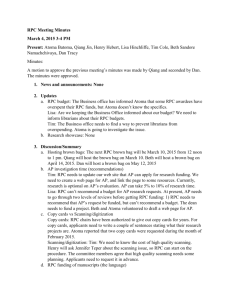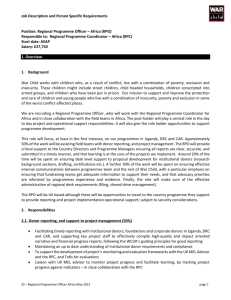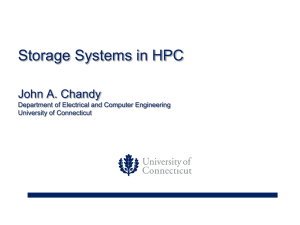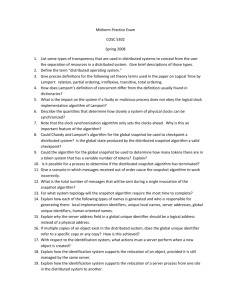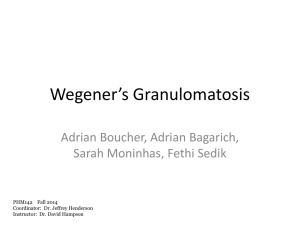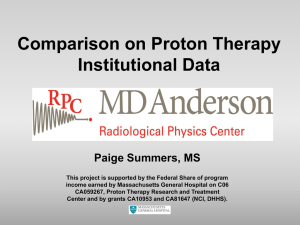Diagnostic evaluation of relapsing polychondritis
advertisement
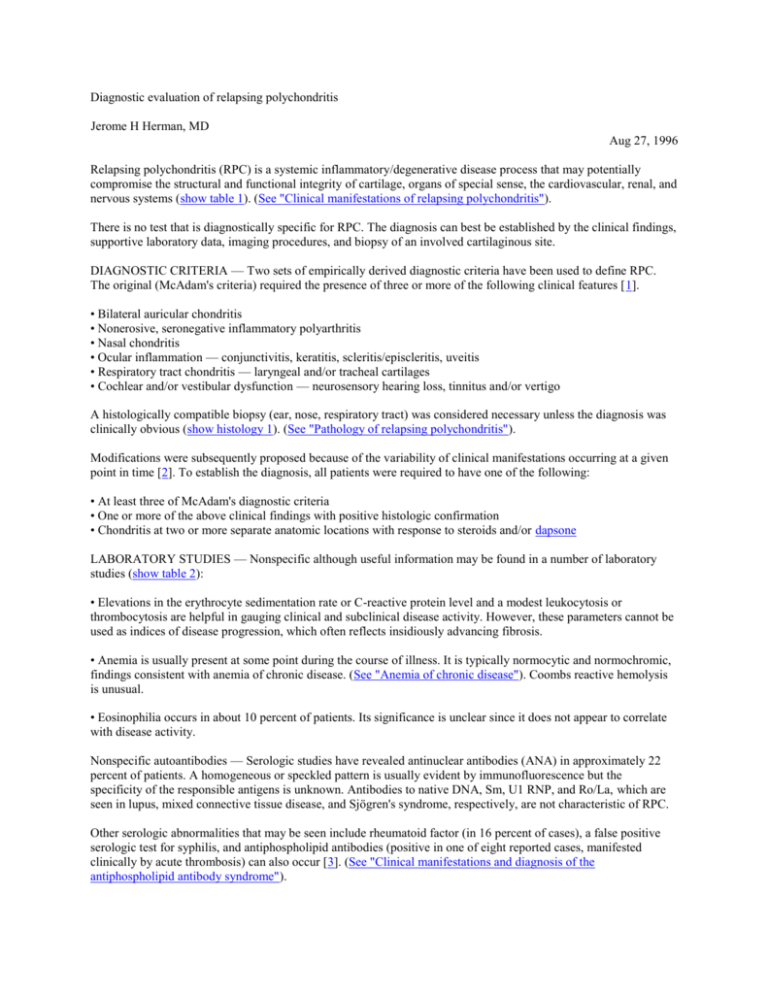
Diagnostic evaluation of relapsing polychondritis Jerome H Herman, MD Aug 27, 1996 Relapsing polychondritis (RPC) is a systemic inflammatory/degenerative disease process that may potentially compromise the structural and functional integrity of cartilage, organs of special sense, the cardiovascular, renal, and nervous systems (show table 1). (See "Clinical manifestations of relapsing polychondritis"). There is no test that is diagnostically specific for RPC. The diagnosis can best be established by the clinical findings, supportive laboratory data, imaging procedures, and biopsy of an involved cartilaginous site. DIAGNOSTIC CRITERIA — Two sets of empirically derived diagnostic criteria have been used to define RPC. The original (McAdam's criteria) required the presence of three or more of the following clinical features [1]. • Bilateral auricular chondritis • Nonerosive, seronegative inflammatory polyarthritis • Nasal chondritis • Ocular inflammation — conjunctivitis, keratitis, scleritis/episcleritis, uveitis • Respiratory tract chondritis — laryngeal and/or tracheal cartilages • Cochlear and/or vestibular dysfunction — neurosensory hearing loss, tinnitus and/or vertigo A histologically compatible biopsy (ear, nose, respiratory tract) was considered necessary unless the diagnosis was clinically obvious (show histology 1). (See "Pathology of relapsing polychondritis"). Modifications were subsequently proposed because of the variability of clinical manifestations occurring at a given point in time [2]. To establish the diagnosis, all patients were required to have one of the following: • At least three of McAdam's diagnostic criteria • One or more of the above clinical findings with positive histologic confirmation • Chondritis at two or more separate anatomic locations with response to steroids and/or dapsone LABORATORY STUDIES — Nonspecific although useful information may be found in a number of laboratory studies (show table 2): • Elevations in the erythrocyte sedimentation rate or C-reactive protein level and a modest leukocytosis or thrombocytosis are helpful in gauging clinical and subclinical disease activity. However, these parameters cannot be used as indices of disease progression, which often reflects insidiously advancing fibrosis. • Anemia is usually present at some point during the course of illness. It is typically normocytic and normochromic, findings consistent with anemia of chronic disease. (See "Anemia of chronic disease"). Coombs reactive hemolysis is unusual. • Eosinophilia occurs in about 10 percent of patients. Its significance is unclear since it does not appear to correlate with disease activity. Nonspecific autoantibodies — Serologic studies have revealed antinuclear antibodies (ANA) in approximately 22 percent of patients. A homogeneous or speckled pattern is usually evident by immunofluorescence but the specificity of the responsible antigens is unknown. Antibodies to native DNA, Sm, U1 RNP, and Ro/La, which are seen in lupus, mixed connective tissue disease, and Sjögren's syndrome, respectively, are not characteristic of RPC. Other serologic abnormalities that may be seen include rheumatoid factor (in 16 percent of cases), a false positive serologic test for syphilis, and antiphospholipid antibodies (positive in one of eight reported cases, manifested clinically by acute thrombosis) can also occur [3]. (See "Clinical manifestations and diagnosis of the antiphospholipid antibody syndrome"). Anti-type II collagen antibodies — It has long been recognized that patients with RPC may have humoral and/or cell-mediated immune responses to extracellular matrix components of cartilage. (See "Etiology and pathogenesis of relapsing polychondritis"). Although their pathophysiologic significance is not completely understood, antibodies to native and denatured type II collagen and proteoglycans have largely been regarded as epiphenomena, emanating from tissue destruction, that lack disease specificity [4,5]. Anti-type II collagen antibodies have been identified in other diseases including rheumatoid arthritis (RA), the seronegative spondyloarthropathies, hip and knee osteoarthritis, and connective tissue disorders such as systemic sclerosis, lupus, and Sjögren's syndrome [6]. Anti-type II collagen antibodies are found in less than one-half of patients with RPC, occurring more frequently in the early active phase of disease [4,5]. Their usefulness in monitoring disease activity and the response to therapy requires further analysis. More recent studies have noted differences in the epitope specificity of the anti-type II collagen antibody appearing in RPC compared to that in RA [7]. The spectrum of anti-collagen response has also been extended. Antibodies to native and denatured type IX and denatured type XI collagen have been identified using immunoblotting and enzyme-linked immunosorbent (ELISA) assays [8,9]. These antibodies also lack specificity. Antibodies to the minor collagens may be paralleled by a cell-mediated immune response as gauged by lymphocyte proliferation [9]. A similar cellular response to cartilage proteoglycans, which paralleled disease activity, has also been reported [10]. Antineutrophil cytoplasmic antibodies — There are several features of RPC which suggest the potential for an increased frequency of antineutrophil cytoplasmic antibodies (ANCA). (See "Clinical spectrum of antineutrophil cytoplasmic antibodies"). • Fourteen percent of patients with RPC have clinically evident vasculitis [11]. (See "Clinical manifestations of relapsing polychondritis"). • Vasculitis is probably operative in the pathogenesis of specific organ system involvement in a far greater percentage of patients. • ANCA is prevalent in Wegener's granulomatosis (WG) which shares a number of features with RPC such as laryngotracheal bronchial disease, necrotizing glomerulonephritis, episcleritis, saddle nose deformity, and auricular chondritis. There is discordance in the literature on the role of ANCA in the vasculitis of RPC. One report, for example, found low titer ANCA (as assessed by immunofluorescence) in eight of 23 patients with RPC [12]. Three had a C-ANCA pattern (diffuse granular cytoplasmic staining) and five had P-ANCA reactivity (perinuclear staining) (show histology 2A-2B). The specificity of these antibodies was examined by ELISA. None of the C-ANCA responders were positive for serine proteinase 3, the dominant antigen responsible for this pattern in Wegener's granulomatosis. Four of the five positive P-ANCA patients were reactive with myeloperoxidase, the antigen associated with PANCA in Wegener's granulomatosis and microscopic polyarteritis. (See "Clinical spectrum of antineutrophil cytoplasmic antibodies"). ANCA positivity in this report appeared to correlate with clinically active disease, although no association was found with either vasculitis or glomerulonephritis. Among the ANCA-negative patients, nine had vasculitis: cutaneous in seven (not further defined); and quiescent Wegener's granulomatosis and a mononeuritis multiplex in one each. In contrast to these findings, a subsequent study demonstrated ANCA reactivity in three of six patients in whom RPC appeared in conjunction with a systemic necrotizing form of vasculitis (Wegener's granulomatosis or microscopic polyarteritis) [13]. Thus, although ANCA may be detected in RPC, its relevance and relationship to associated vasculitis require further analysis. Other studies — Total hemolytic complement and C3 and C4 levels are usually normal in RPC [14]. Occasional elevations in complement levels probably reflect an acute phase response. The prevalence and significance of circulating immune complexes have not been systematically evaluated. Using varying methodologies, immune complexes have been identified in 15 of 35 reported cases (43 percent) [4]. Cryoglobulins appear to occur less frequently, being detected in seven of 32 cases (22 percent) compiled from the literature. Transient increases may occur in IgG, IgA or IgE levels. Serum protein electrophoresis may show nonspecific abnormalities, such as a decrease in albumin and elevations in the alpha-1 and gamma globulin regions. Still in a preliminary stage are studies investigating the feasibility of measurement of serum content of noncollagenous cartilage-specific adhesive glycoproteins as a clinical index of enhanced catabolism and a means of monitoring disease activity [15,16]. Although analysis of cerebrospinal fluid may be normal in the presence of clinical evidence of central nervous system involvement, there is usually a pleocytosis with a predominance of lymphocytes, a protein content that is either normal or slightly elevated, and a normal glucose concentration [17]. EVALUATION FOR PULMONARY INVOLVEMENT — Functional and anatomical evaluation for upper and lower airway disease is essential in evaluation and management of the disease. (See "Treatment of relapsing polychondritis"). Pulmonary function testing may show varying degrees of inspiratory and/or expiratory obstruction, its magnitude varying with the location and character of the pathologic process [18]. A complete spirometric evaluation should include both maximal inspiratory and expiratory flow-volume loops (show figure 1). (See "Flowvolume loops"). Expiratory obstruction correlates well with bronchoscopically defined abnormalities such as collapse and/or narrowing. In contrast, inspiratory obstruction correlates poorly with bronchoscopic findings in the extrathoracic airway. As an example, a normal appearing larynx associated with decreased maximum inspiratory flow may represent abnormal cricoarytenoid joint motion. It is important to appreciate that bronchoscopy itself may pose a risk in the presence of chronic asphyxia, and death may occur. On the other hand, imaging studies can provide important information noninvasively in the evaluation of the larynx and trachea. Chest radiography — A plain chest film can demonstrate one of more of the following: • Tracheal narrowing • Opacities secondary to pneumonia or atelectasis induced by obstruction. • Increased pulmonary vascularization or pulmonary edema • A lateral view of the neck may reveal calcification of the tracheal or laryngeal cartilage. Use of laryngography as a means of outlining the airway carries a risk of acute airway compromise and should be avoided if possible. Computed tomography — CT scanning is more useful than conventional tomograms and laryngotracheograms in evaluating laryngotracheal bronchial wall thickening, luminal narrowing, and cartilaginous calcification [19]. It can readily provide an explanation for hoarseness, dysphagia, or respiratory distress in patients with RPC. Attention to the technique of performing the scan may be helpful. If the CT scan is only performed during inspiration (which is the usual method), changes in the caliber of the tracheobronchial tree may be missed. Thus, at least selected slices covering the major airways should be obtained in expiration as well (show radiograph). The CT scan is partially limited by its inability to distinguish fibrosis from inflammation. Magnetic resonance imaging — MRI, with its multiplanar imaging capability and its superior soft tissue contrast, is particularly useful for evaluating the trachea and larynx. It distinguishes fibrosis from inflammation (in contrast to CT) and inflammation from edema even in the presence of subclinical disease [20]. There are two potential limitations to MRI. The length of time required for imaging may create a problem in the patient with respiratory compromise, and there may be low anatomical resolution due to image degradation caused by respiratory motion. Gallium scan — Gallium radionuclide imaging may, in some cases, permit assessment of the presence and extent of active pulmonary inflammation [21]. It cannot be recommended for routine use without further assessment. EVALUATION FOR CARDIAC INVOLVEMENT — Active inflammation of the heart valves and large arteries may be totally asymptomatic and difficult to detect clinically. (See "Clinical manifestations of relapsing polychondritis"). The following findings may be seen: • A chest film may disclose cardiomegaly or identify aortic arch widening or prominence of the ascending or descending aorta. • Arrhythmic events secondary to myocarditis or myocardial ischemia can be detected on the electrocardiogram. • Doppler echocardiography is the method of choice for the evaluation of cardiac valve status, measurement of the degree of valvular regurgitation, and for imaging of left ventricular size and function. Consideration should be given to a baseline determination in all patients. Enlargement of the ascending aorta can be further assessed by transesophageal echocardiography or by MRI. The latter can also be used to locate aneurysmal dilatation along the course of the aorta. Invasive procedures such as aortography and coronary angiography may be indicated for the evaluation of vasculitis or aneurysms. However, their use may be potentially dangerous because of increased fragility of the vessel wall. Vascular injury can induce a false aneurysm, dissection, or thrombosis. OTHER IMAGING STUDIES — Other radiologic studies may provide important information in selected patients. • Calcifications in the ears and nose (which lack specificity) can be identified by CT scanning and x-ray. • Skeletal films may show juxta-articular bone demineralization or erosive changes within peripheral joints, the symphysis pubis, vertebral end plates or sacroiliac joints. • Radionuclide imaging using Tc-99m diphosphonate bone scans and gallium-67 citrate scintigrams may identify increased tracer concentrations in actively involved cartilaginous sites [22]. DIFFERENTIAL DIAGNOSIS — RPC is distinguished from other diseases by the coexistence of usually widespread potentially destructive inflammatory lesions involving cartilaginous structures throughout the body, organs of special sense, and the cardiovascular system. However, the variable, unpredictable expression of clinical features over time may make the diagnosis difficult to establish. Auricular inflammation — Auricular inflammation simulating that occurring in RPC (show picture 1A-1B) may be secondary to an acute pyogenic or chronic granulomatous infectious process such as tuberculosis, fungal disease, syphilis, or leprosy. The absence of regional lymphadenopathy should trigger the suspicion of a noninfectious process. It is important to appreciate that the expression of auricular cellulitis and chondritis following even minor burns may be delayed, in some cases by weeks, occurring at sites that have long since healed. On occasion, chondrodermatitis helicis nodularis, an inflammatory and degenerative skin lesion of unknown etiology, may cause confusion because of its histologic resemblance to RPC. Its more localized, circumscribed distribution and the absence of other features of disease assist in the differentiation. Cystic chondromalacia usually presents as a painless, non-tender cystic swelling involving the upper ear region. Serous fluid can often be aspirated. Auricular inflammation caused by trauma such as ear piercing, irritant chemicals and frostbite must be excluded. Saddle nose deformity — Chondritis with destruction of nasal cartilage and the potential development of a saddle nose deformity, although characteristic of RPC (show picture 2), may also be induced by an infectious granulomatous lesion, Wegener's granulomatosis, lymphomatoid granulomatosis, lethal midline granuloma, carcinoma, or lymphosarcoma. A useful differentiating feature is the absence of mucosal inflammation in RPC. Narrowing of the airway — Airway narrowing can result from either an intrinsic lesion, or extension or compression afforded by an extrinsic process. • Epiglottitis must always be considered when suspecting an upper airway obstruction. The chief complaint is invariably the sudden onset of a severe sore throat in a previously healthy individual. Death may quickly ensue if the diagnosis is not promptly established and appropriate therapy instituted. • Airway lesions may result from trauma induced by endotracheal intubation, neoplastic disease, Wegener's granulomatosis, the saber-sheath trachea associated with chronic obstructive pulmonary disease, or the rare tracheobronchopathia osteochondroplastica characterized by osseocartilaginous mucosal nodules which project into the lumen of the larynx, trachea and bronchi. • The larynx and tracheobronchial tree may be involved by the localized tumor-forming variant of amyloidosis. Individual and coalescent nodules may develop in the supraglottic or subglottic regions of the larynx in this disorder. • Rhinoscleroma, a chronic granulomatous disease caused by Klebsiella rhinoscleromatis, is endemic to Asia, Africa and South America. It may progress to a cicatricial stage with dense fibrotic narrowing of the larynx or trachea. • The larynx may rarely be involved in pemphigus vulgarus, the supraglottic region having an erythematous appearing ulcerated mucosa with a fibrinous exudate. Laryngeal lesions have been reported in 10 percent of patients having cicatricial pemphigoid. Bullae or ulcers mainly occur on supraglottic structures and may be associated with odynophagia. • Infectious and noninfectious mediastinal lesions (such as tuberculosis, histoplasmosis and sarcoidosis) may be associated with chronic inflammation, thickening, and stenosis of the tracheal wall. Mediastinal lymphadenopathy has not been described in RPC. Ocular inflammation — Ocular inflammation, audiovestibular dysfunction, and polyarthritis may be seen in systemic necrotizing forms of vasculitis such as polyarteritis nodosa, Wegener's granulomatosis, Cogan's syndrome, and Behcet's disease. However, these are not generalized chondropathies like RPC. Wegener's granulomatosis may be particularly difficult to distinguish from RPC because of the potential of additional shared expressions of auricular chondritis, saddle nose deformity, laryngotracheal bronchial disease, glomerulonephritis, nervous system involvement, and the presence of ANCA. The correct diagnosis must be established by histologic means and by the recognition of more specific clinical features such as cavitary lung lesions in Wegener's granulomatosis, and diffuse dynamic tracheobronchial collapse and aortic aneurysms in RPC. An overlap is the most plausible explanation when discriminating data do not allow differentiation. Ocular inflammation in conjunction with polyarthritis must be further distinguished from rheumatoid arthritis, the seronegative spondyloarthropathies (ankylosing spondylitis, Reiter's syndrome, psoriatic arthritis), and sarcoidosis. The individual characteristics of these diseases usually permits the diagnosis to be established. The presence of aortitis and aortic aneurysms warrants consideration of developmental connective tissue diseases such as Marfan's and Ehlers-Danlos syndromes as well as idiopathic medial cystic necrosis, syphilis, and arteriosclerosis. Costochondritis — Tietze's syndrome should be considered in the differential diagnosis of costochondritis as well as infection (pyogenic organisms, tuberculosis, fungal, viral) associated with trauma, a sternotomy incision or drainage from intrathoracic or peritoneal foci, chest wall irradiation, and deep chest wall burns (particularly of electrical origin). Costochondritis secondary to hematogenous seeding of Candida albicans in intravenous drug abusers has become increasingly recognized. (See "Major causes of musculoskeletal chest pain").
